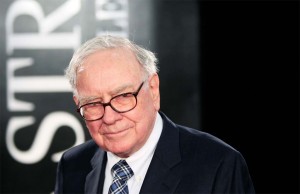Even as – and perhaps because of – the U.S. Treasury continues selling down its remaining stake in General Motors, billionaire investment guru Warren Buffett is rapidly increasing his own holdings in General Motors.
According to a federal filing, Buffett’s investment arm Berkshire Hathaway has increased its holdings in the giant Detroit maker by 60%. He now has 40 million shares, or 2.9% of GM’s outstanding stock.
That news came just days after Treasury officials advised Congress they has sold off around 25 million more shares in GM for a total sale of $876.9 million. The federal government now holds just 136 million shares, a little more than a quarter of the 500-million-share stake it gained after the maker’s 2009 bankruptcy, in return for a $49.5 billion bailout.
GM has garnered increasing interest from investors in recent months, in part due to increasingly positive reviews of its latest products, its improving financial picture and its return to the S&P 500 stock index. A number of investment funds are required to purchase stocks covered by that index.
GM shares tanked at around $19 a share in mid-2012 but have sharply rebounded in recent months, hitting a 52-week $37.71 high before settling back to $34.71 during late-morning trading on Friday.
Buffett has been building his GM stake since 2012 when he bought 10 million shares near the stock’s low point. He made a significant increase in his holdings between April and the end of June, according to his federal filing, just as the Treasury began speeding up its sell-off.
The Obama Administration announced plans earlier this year to completely exit GM by April of 2014. That move was encouraged by GM, which has wanted to get out from under the terms set as part of the bailout – including severe restrictions on senior management compensation.
Meeting with reporters, GM North America President Mark Reuss expressed optimism about Berkshire Hathaway’s stock purchases.
“We work really hard every day to do the right things and make the right cars that people want to buy. When someone does something like that it makes us all feel we’re on the right track,” Reuss said.
“Frankly, it’s been a tough four years coming out the financial crisis we were in and a little bit of validation here and there is OK. But we’ve got a lot of work to do, and we’ve got to keep our heads down here and keep it going.”
(Click Here to read about GM’s truck sales exceeding expectations.)
GM has gotten a number of boosts this year: starting with the announcement that its new Cadillac ATS model was named North American Car of the Year by a jury of 50 automotive journalists last January. It has since received several other significant, third-party endorsements, starting with J.D. Power and Associates in June noting GM was the top-ranked maker on its closely watched Initial Quality Survey for the first time. And last month, influential Consumer Reports magazine declared the Chevrolet Impala the market’s best sedan.
(Parts shortages may impact auto industry rebound. For more, Click Here.)
Meanwhile, the return to the S&P 500 has also encouraged investors to trade GM shares.
The once-bankrupt Detroit maker does have its share of problems, however, perhaps most notably its struggling European subsidiary Opel, which has now lost money for 14 consecutive years. But GM insists its latest turnaround plan is bringing Europe back to a breakeven point.


Tax payers however are out billions of dollars while GM took the funds and invested it in China instead of the U.S. to keep or create new jobs. What a scam.